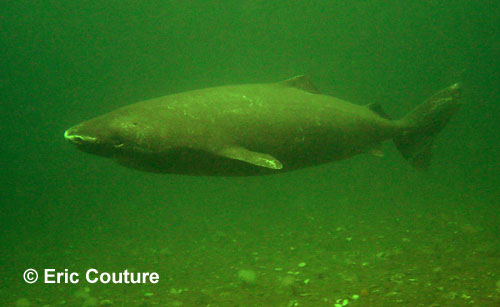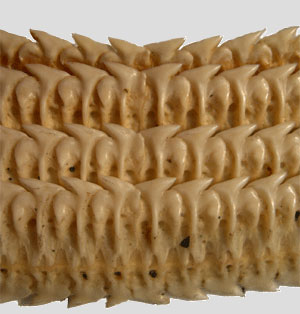Polar Seas: Life Under the Ice
Greenland Shark
Although polar seas may seem an unlikely habitat for a shark, the Greenland Shark (Somniosus microcephalus) is astonishingly abundant in Arctic waters. This species has long been commercially harvested off Norway and western Greenland, where up to 30,000 have been taken in a single year. Historically, Greenland Shark livers have been an important source of vitamin A and lamp oil, but now are taken primarily as a source of an extremely durable machine lubricant.
Just the Facts:
Size:
Reproduction:
Diet:
Habitat: Deep Sea, Polar Sea Depth: 65-7,220 ft (20-2,200 m), possibly shallower at night Distribution: Arctic, ?South Pacific, Western North Atlantic, Eastern North Atlantic/ Mediterranean, Southern African, Central South Indian |
The flesh of Greenland Sharks is highly poisonous to warm-blooded animals, including sled dogs, ravens, fulmars, and humans. Eating even a small quantity of Greenland Shark flesh often results in stiff movements, hyper-salivation, vomiting, explosive diarrhea, conjunctivitis, muscular twitching, respiratory distress, convulsions, and — in severe cases — death. These nasty effects can be greatly reduced by boiling Greenland Shark meat in several changes of water or by burying the meat for several months above the high tide-line so that microbial action can chemically modify it (as in the preparation of lutefisk, Iceland’s national dish). In 1991, a Danish research team isolated TMAO as the probable toxic ingredient of Greenland Shark flesh.
As in deep-sea sharks, TMAO in the tissues of Greenland Sharks helps stabilize their enzymes and structural proteins against the debilitating effects of cold and extreme pressure. Although during bright summer months Arctic water temperature may reach 50 to 54 degrees Fahrenheit (10 to 12 degrees Celsius), in the darkest depths of Arctic winter, water temperatures may plummet to as low as 39 or even 28 degrees Fahrenheit (4 or even -2 degrees Celsius). At such temperatures, even the hardiest proteins would cease to function properly without some form of chemical protection; polar fishes manufacture glycoproteins as a built-in anti-freeze and polar sharks store urea and TMAO to prevent ice crystal formation and stabilize proteins. At lower latitudes, the Greenland Shark apparently remains within its preferred temperature regime by inhabiting great depths — in September 1990, an individual estimated to be 21 feet (6 metres) long was photographed off the coast of Georgia, U.S.A., at a depth of 7,220 feet (2,200 metres). At this depth, the ambient pressure is almost 220 atmospheres or about 3,300 pounds per square inch (9,700 kilograms per square centimetre). Small wonder that the tissues of the Greenland Shark are chemically protected by high concentrations of TMAO.

Even with the protein stabilizing effects of TMAO, the Greenland Shark’s life processes seem to occur in slow-motion. On average, biochemical processes occur three times more slowly for every 18-degree Fahrenheit (10-degree Celsius) drop in operating temperature. It’s not surprising, then, that the Greenland Shark grows at a positively glacial pace: a 9-foot, 1-inch (2.77-metre) specimen tagged off western Greenland in 1936 was recaptured 16 years later, when it measured 9 feet, 4.5 inches (2.86 metres) — indicating an average growth rate of less than 1/4 inch (0.56 centimetres) per year. At that rate, a 21-foot (6-metre) long Greenland Shark could very well be several centuries old.
Considering that it has been commercially harvested for over 120 years, surprisingly little is known about the basic life history of the Greenland Shark. It was not until 1957 that we knew this species does not lay eggs in the bottom mud, instead retaining them within each mother shark’s body until they are born alive after an indeterminate gestation. About 10 pups are born per litter, each measuring about 35 inches (90 centimetres) in length. We have no idea how long either sex of the Greenland Shark takes to reach maturity. Based on the average age at maturity for the related Spiny Dogfish (Squalus acanthias) and adjusting for differences in size and water temperature, I propose a very rough guesstimate of age at maturity for the Greenland Shark at 40 years for males and 70 years for females. However, if even 1 percent of the annual Greenland Shark catch of Norway or Greenland were sampled biologically, such speculation would not be necessary as we would thereby know a great deal more than we do about the basic biology of this enigmatic creature.
 Detail of tooth band of Somniosus microcephalus |
We also know very little about when or where the Greenland Shark bears
its young. In August 1981, two roughly 3-foot (1-metre) long newborn
Greenland Sharks, a male and a female, were caught by a Russian research
vessel off Jan Mayen Island, in the Norwegian Sea. They were caught at a
depth of 800 to 1,000 feet (250 to 300 metres) at a site where the bottom
lay at a depth of 6,600 feet (2,000 metres). Based on traces of the yolk
sac and the development of the teeth, dermal denticles and internal organs
of the male, it was estimated to be 10 to 15 days old. This led the
researchers to conclude that, in the Norwegian Sea, Greenland Sharks give
birth during July and August. It is always dangerous to draw conclusions
from so little data, but — if the midwater capture depth of the Norwegian
Sea pups is typical of Greenland Sharks — this may represent an
antipredatory strategy, allowing newborns of this species to avoid
predation by large boreal sharks inhabiting the epipelagic and deep
benthic ocean zones — such as the Blue Shark (Prionace glauca) and the
Bluntnose Sixgill (Hexanchus griseus), respectively.
With upper teeth that resemble spikes and lower teeth that form a saw-like
cutting edge, the Greenland Shark is an opportunistic predator/scavenger,
feeding upon virtually anything it can grasp within its short, powerful
jaws. Among the food items that have been found in Greenland Shark
stomachs are seaweeds, jellyfishes, amphipods, snails, brittlestars, egg
cases from the Arctic Skate (Ambryraja hyperborea), Arctic Char (Salvelinus
alpinus), Capelin (Mallotus villosus), Rosy Soldierfish (Hoplostethus
mediteraneus), sculpins, Greenland Halibut (Reinhardtius
hippoglossoides), European Ling (Molva molva), Arctic Cod (Boreogadus
saida), Atlantic Wolffish (Anarhichas lupus), Arctic Lumpsucker
(Cyclopteropsis macalpini), other Greenland Sharks, seabirds,
Ringed Seal (Phoca hispida), Beluga (Delphinapterus leucas)
and Narwhal (Monodon monoceros) blubber, an entire Caribou (Rangifer
tarandus) minus its antlers, horses that apparently fell through thin
ice and drowned, and even part of a human leg, still wearing a fur-topped
Inuit boot.
Although they offer little resistance when captured — being hauled through the ice by their gills like so much wet laundry — Greenland Sharks may not be as preternaturally sluggish as they have long been thought to be. It is easy to imagine a few Caribou drowning each year as they cross flooding rivers during their annual spring migration and eventually ending up in the sea, where they are scavenged by Greenland Sharks. But several biologists working in Canada’s Far North have reported Greenland Sharks fiercely attacking Caribou as they cross estuaries along their annual migration route. More recently, a reputable Canadian wildlife biologist reported observing a Greenland Shark exploding from the water with a tremendous splash, grasping a near-shore Caribou by the (obviously startled) face, dragging it — kicking and bugalling — into the water, and then eating it. In addition, the Greenland Shark is apparently capable of catching some astonishingly speedy prey, such as squids, herrings, Atlantic Salmon (Salmo salar), and even whole Harbor Porpoise (Phocoena phocoena). How the apparently slow-swimming Greenland Shark manages to catch such speedy entrées remains something of a mystery.
A study of 1,505 Greenland Sharks off eastern Greenland found that 84.4% of individuals had a strange, 2.5-inch (7-centimetre) long copepod, Ommattokoita elongata, attached to each cornea, 14.5% had the same copepod on one eye, and only 1.1% had no such copepod on either eye. This high frequency of co-occurrence led to speculation that the pinkish-white copepod may be bioluminescent — its soft glow luring prey animals within the striking range of the Greenland Shark — and thus the two species mutually benefited from their symbiotic association. Unfortunately for this nifty theory, later work has demonstrated that this parasitic copepod is not luminescent and that it causes severe corneal damage to its host, possibly blinding it. This pale copepod is, however, quite visible underwater from fairly close range, so it remains feasible that its corneal parasite may lure prey to the Greenland Shark which may then ambush it from close range. Whether it relies on its copepod lures or slow, stealthy stalking to get close to its prey, the Greenland Shark’s short, broad caudal fin is ideally suited for sudden bursts of rapid acceleration, possibly enabling it to catch its prey by surprise.
The Greenland Shark may also be behind a bizarre mystery off Canada’s Atlantic coast. On Sable Island, off the coast of Nova Scotia, numerous carcasses of Grey Seals (Halichoerus grypus), have been found washed ashore with their skins partially peeled off in great, spiraling strands. A researcher based on the Island firmly believes that the Greenland Shark may be responsible for these strange wounds. I have examined her evidence and suspect that these wounds — which are remarkably evenly spaced and, in every case I have seen, spiral in an anti-clockwise direction — are far more likely due to a combination of boat propellers and subsequent tearing along the cuts by various scavengers, including Spiny Dogfishes, sea gulls, rats and feral dogs. The collagenous substructure of seal skin forms two helices that cross one another at varying angles along the length of body, so that is likely that — once sliced open by whatever mechanism — the skin would tend to rip off in regular, spiraling loops. It is, I must admit, entirely possible that Greenland Sharks participate in this kind of post-trauma skin stripping, but I am inclined to look for culprits that are more abundant in the shallow waters around Sable Island.
Greenland Shark Bibliography
More about: Arctic Sharks |
Greenland
Shark parasites

